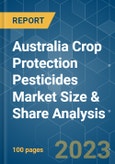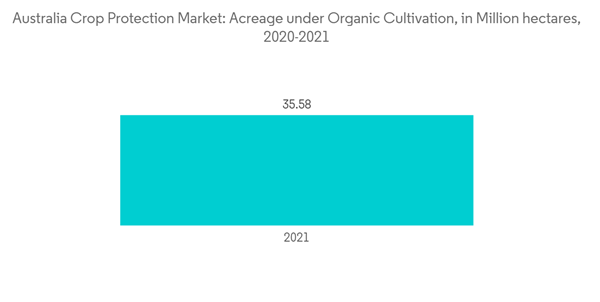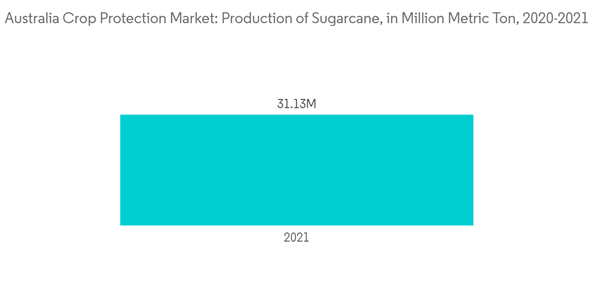The Australia Crop Protection Chemicals (Pesticides) Market size is estimated at USD 1.57 billion in 2023, and is expected to reach USD 1.98 billion by 2028, growing at a CAGR of 4.70% during the forecast period (2023-2028).
Key Highlights
- In Australia, the pesticide industry has been witnessing relatively steady growth, primarily attributed to the demand for biopesticides and farmers' adoption of herbicide-resistant crops. While the prevalence of chemical or synthetic pesticides in crop protection is expected to continue, human, animal, and environmental health concerns are expected to play key roles in driving the growth of biopesticides.
- The Australian Pesticides and Veterinary Medicines Authority (APVMA) regulates crop protection chemicals' use in Australia and is responsible for registering and approving pesticides and other agricultural chemicals. The APVMA ensures that these chemicals are safe for human health and the environment and effective in protecting crops.
- Increasing demand for food, pests and diseases, government support, technological advancements, increasing exports, and climate change rate drive the Australian crop protection chemicals market. Australia is a mature market for pesticides. Crops like wheat, barley, sugarcane, canola, cotton, vegetables, and fruits are largely grown in Australia and are major users of pesticides.
Australia Crop Protection Chemicals Market Trends
Rising Adoption of Bio-based Products
- Biopesticides are derived from natural materials, such as plants, bacteria, and fungi, and are typically less harmful to non-target organisms than conventional pesticides. Biopesticides are designed to target specific pests. They work by disrupting the biological processes of the pest or by introducing a natural predator or disease to control the pest population. Because biopesticides are often more targeted in their approach, they can be more environmentally friendly and safer for humans and non-target organisms. Although the biopesticide segment generated only a small fraction of the revenue generated by the chemical industry, it is likely to witness significant growth during the forecast period in Australia.
- Developing new pesticide products takes nearly ten years and an expenditure of around USD 250 million. Besides, it takes 12-13 years and roughly USD 130 million to develop genetically modified (GM) crops. These factors make bio-based products increasingly popular among Australian farmers practicing environment-friendly agriculture. The demand for such products will likely drive the country's crop protection chemicals market during the forecast period.
- Additionally, the area under organic cultivation is also increasing in the country. Australia has the largest area of land under organic farming, i.e., 35.59 million hectares in 2021, which indicates the rising demand for bio-based solutions. In 2020, the Australian Minister for Agriculture, Water, and the Environment created a national regulatory framework for domestically producing and selling organic products.
Sugarcane is the Highest Produced Crop in Australia
- Pesticides are used widely in the sugarcane industry in Australia to prevent or mitigate losses from such conditions. Several companies, such as Syngenta and Bayer, have products primarily aimed at control of these diseases. To keep the production of sugarcane growing, the use of crop protection chemicals is vital. Thus, demand among sugarcane cultivators will drive the market during the forecast period.
- Along with wheat and cotton, sugarcane is one of the region's most popular and widely cultivated plants. Sugarcane was the highest-produced crop in Australia in 2021, with a production of 31.1 million metric tons. However, sugarcane production is often restricted by dangerous diseases, such as red rot, sour rot, and rust.
- With the increasing land being converted to agricultural production, particularly sugarcane, inputs of pesticides into the Great Barrier Reef area have increased with time. However, the use of organochlorines such as hexachlorocyclohexane (HCH) and dichlorodiphenyltrichloroethane (DDT) have ceased. The quantities of the insecticide chlorpyrifos and herbicides atrazine, diuron, and 2,4-D applied in the Herbert catchment have increased in the last few years.
Australia Crop Protection Chemicals Industry Overview
The crop protection chemicals market in Australia is consolidated, with major players, including Syngenta International AG, Bayer CropScience AG, Corteva AgriScience, BASF SE, and UPL Limited, accounting for more than 50% share in the global market. New product launches, mergers and acquisitions, and partnerships are the major strategies these leading companies adopt in the market. These companies also focus on investing in innovations, collaborations, and expansions to increase their market share.Additional Benefits:
- The market estimate (ME) sheet in Excel format
- 3 months of analyst support
Table of Contents
1 INTRODUCTION
4 MARKET DYNAMICS
5 MARKET SEGMENTATION
6 COMPETITIVE LANDSCAPE
Companies Mentioned (Partial List)
A selection of companies mentioned in this report includes, but is not limited to:
- Bayer CropScience AG
- Syngenta International AG
- BASF SE
- Corteva Agriscience
- UPL Limited
- ADAMA Agricultural Solutions
- FMC Corporation
- Nufarm Ltd
- Sumitomo Chemicals
- American Vanguard Corporation
- Isagro Spa
- Bioworks Inc.
- Ishihara Sangyo Kaisha Ltd
- Marrone Bio Innovations Inc.
- Nippon Soda
Methodology

LOADING...










